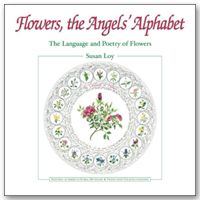LITERARY
CALLIGRAPHY
LINKS


The following excerpts from "Flowers, the Angels' Alphabet" by Susan Loy are © 2001 by CSL Press and Susan Loy. All rights reserved.
INTRODUCTION
This book grew out of my use of the historic language of flowers to
create a series of Literary Calligraphy® watercolor paintings. The
language of flowers is the tradition of associating flowers with
sentiments or virtues - the red rose signifies love; rosemary stands for
remembrance. I was first attracted to the language of flowers by virtues
such as strength of character and loyalty, and I have been charmed by
meanings like "ambassador of love", "hope in adversity", and "return of
happiness". The language of flowers provides a way to focus on a specific sentiment or virtue; the flower becomes an emblem for that quality or feeling.
The tradition of associating flowers and sentiments is ancient and
universal. It was formalized during the Victorian era in England,
France, and America with the publication of hundreds of language of
flowers books during the nineteenth century. Language of flowers books
contain a dictionary of flowers and their associated meanings, generally
referred to as sentiments. They often include an additional dictionary
of sentiments with their associated flowers. Most include sections of
poetry either about flowers or about the sentiments they represent. Some
books include botanical and horticultural information, plant lore, and
other details about the plants. Some have floral calendars with flowers
for each day of the year or sentiments for the week or month. A few
include a fortune-telling system, referred to as a "floral oracle". Many
books contain illustrations, typically one to six color plates.
"Flowers, the Angels' Alphabet" follows the tradition of the language of
flowers book. It features a dictionary of the American language of
flowers and twenty-eight color reproductions of my Literary Calligraphy®
watercolor paintings - part of my language of flowers series. The
illustrations highlight chapters on twenty-four individual flowers. Each
chapter includes a reproduction of one of my original watercolors - a
hand-lettered presentation of the flower's sentiment from the language
of flowers as well as a poem or verse that expresses that sentiment. In
this way, "the red rose means love" is accompanied by Robert Burns's
poem, "My luve is like a red, red rose..." and surrounds a painting of
the red rose. Four additional reproductions are large pieces that
feature a total of 115 flowers. Three of these pieces contain alphabets
of flowers, from Aster to Zinnia and Azalea to Zephyr Flower.
The dictionary of the American language of flowers has about 2,900
entries, which I have compiled from one dozen historic books published
between 1832 and 1891, by American writers and publishers of the
nineteenth century. It includes a vocabulary of some 1,400 flowers with
their associated sentiments, and 1,500 sentiments and their associated
flowers. I have edited the dictionary to eliminate some repetition,
while retaining many of the subtle variations of meaning or flower type
recorded by the nineteenth century writers.
When I first came to use the language of flowers for my art work, I was
confronted with questions as to which flower a writer meant when he or
she listed aster or bellflower, or what in the world is hackmetack? The
appendix reflects my efforts to sort all of this out. Its 2,300 or so
entries document the source of each flower's meaning as well as the
botanical species identified by the writers of the nineteenth century.
Because I use my dictionary to create alphabetic lists of flowers, the
appendix includes extensive cross-references of flowers by common as
well as botanical name. In addition to dictionaries from one dozen
American books, it incorporates dictionaries from three British books by
Shoberl, Tyas, and Greenaway, as well as a translation of Charlotte de
Latour's listings from Le Langage des Fleurs.
I have compiled these dictionaries from books in my personal collection
and from my research. I hand copied my first American dictionary in
Alderman Library's rare book room at the University of Virginia. Since
then I've searched for language of flowers books in antiquarian book
shops throughout America, England, and Wales and, more recently, on the
Internet.
The language of flowers has been called "the angels' alphabet", a
vocabulary of sentiments and virtues.
"Flowers are the alphabet of angels' -- whereby
This book is dedicated to the angels' alphabet.
They write on hills and fields mysterious truths."
John S. Adams, Flora's Album
NEXT CHAPTER EXCERPT: HISTORY OF THE "LANGUAGE OF FLOWERS" BOOK
| Purchase "Flowers, the Angels' Alphabet"... |  |
Our Privacy Policy guarantees a safe and secure transaction!
[BOOK CHAPTER EXCERPTS] [BOOK REVIEWS] [PRESS ROOM RESOURCES]
[LISTING OF EXCERPTS] [CSLPRESS HOME PAGE]